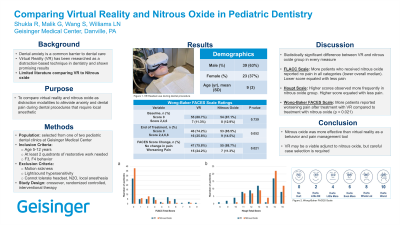Patient Management
62 - Comparing Virtual Reality and Nitrous Oxide in Pediatric Dentistry


Rupini Shukla, DDS, MPH (she/her/hers)
PGY-2 Resident
Geisinger Medical Center, Danville, PA
Geisinger Medical Center
Danville, Pennsylvania, United States- GM
Gayatri Malik, DMD, PhD
Associate Program Director
Geisinger Medical Center, Danville, PA
Danville, Pennsylvania, United States - SW
Shengxuan Wang, MS
Geisinger Medical Center, Danville, PA
- LW
Lacey N. Williams, DMD
Attending Physician
Geisinger Medical Center, Danville, PA
Geisinger Medical Center
Danville, Pennsylvania, United States - LW
Lacey N. Williams, DMD
Attending Physician
Geisinger Medical Center, Danville, PA
Geisinger Medical Center
Danville, Pennsylvania, United States - NS
Natalie Stinton, DMD
Program Director
Geisinger Medical Center, Danville, PA
Danville, Pennsylvania, United States
Presenting Author(s)
Co-Author(s)
Research Mentor(s)
Program Director(s)
Purpose: To compare virtual reality (VR) and nitrous oxide as distraction modalities to alleviate anxiety and dental pain during dental procedures.
Methods: Sixty-two participants, aged 5 to 12 years, were included in this crossover study. Participants were randomized during their first visit to receive either nitrous oxide or VR, followed by the alternative option at their subsequent visit. All participants received restorative treatments, such as dental restorations, crowns, and extractions using local anesthesia. The participants were asked to rate their pain with the Wong-Baker Faces scale before and after the procedure. After administration of local anesthesia, the provider gave the participant a FLACC score to rate the child’s reaction during the injection. The provider completed the Houpt Crying and Movement Scale as an assessment of the child’s overall behavior after the procedure was completed.
Conclusions: Nitrous oxide performed better to reduce dental pain and anxiety than virtual reality. Virtual reality may be a viable non-pharmacologic alternative or adjunct modality to nitrous oxide, but it requires careful case selection.
Results: There was a statistically significant difference between participant behavior with VR distraction compared to nitrous oxide when measuring the Houpt (P < .001), FLACC (P < .001), and Wong-Baker Faces scores (P = .021). Scores of “definitely p</span>ositive” behaviors were observed more frequently in the nitrous oxide group (70% versus 50%). The VR group exhibited a higher incidence of “negative" behaviors (15% versus 5%).
Identify Supporting Agency and Grant Number:

.jpg)